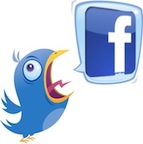
 There’s always been a dueling standoff between Twitter and Facebook. Though both are used for slightly different purposes and outreach campaigns, any successful media giant knows to never to rest on its laurels – especially when media and technology are constantly converging and evolving.
There’s always been a dueling standoff between Twitter and Facebook. Though both are used for slightly different purposes and outreach campaigns, any successful media giant knows to never to rest on its laurels – especially when media and technology are constantly converging and evolving.
The two entered 2011 with Facebook soaring above Twitter in terms of users, Facebook with about 500 million compared to Twitter’s markedly less 106 million. Facebook’s users met with some changes in 2011, including a practical timeline feature, a slight personal appeal to individual branding, which included the ability for individual users to post publicly, and for non-friends to opt in for subscriptions.
In the same year Twitter became a solidified agent of change with its continued record ability to capture (and sometimes create) breaking news, as well as the unfavorable adaptation of spammers now manipulating Twitter accounts for their own annoying campaigns.
But independently of Facebook, Twitter has seen its own meteoric rise in the last couple years alone. According to a Pew Report on Twitter, the social media company went from an 8% usage among adults in 2010 to 13% in 2011, adding that “Twitter use by internet users ages 25-34 has doubled since late 2010 (from 9% to 19%) and usage by those ages 35-44 has also grown significantly (from 8% to 14%).
Furthering their recent style shift, Twitter announced yet another design change just this month. The goal is to draw in new users and keep them on Twitter for longer, while attracting more advertisers and revenue. The idea is to let companies develop brand pages that showcase them more prominently through logos and taglines, including the ability to push tweets up the timeline, much like Facebook lets you ‘feature’ posts. The change comes at the heel of Google+ and its announcement for brand pages.
Twitter intends to continue growing those figures, and with a Saudi prince and his consulting firm recently investing $300 million into Twitter, we can be sure that 2012 will be packed with new changes for Twitter. But will a $300 million investment be enough to boost Twitter’s estimated $8 billion, especially when compared with Facebook’s already established rapport with advertisers and its staggering value of over $50 billion? Perhaps, but it’ll take more than just one year to determine the results.
The first challenge Twitter should (and might) work to meet is adaptability. Currently, Twitter apps like TweetDeck and Hootsuite make it much easier and faster to side step Twitter’s own platform to use the service. You can use Twitter without actually using Twitter, and that’s what many of us do – and we who do stay on these platforms obsessively throughout the day. If Twitter can merge its design change to evolve its functionality, it might again be a real power play and reclaim a huge percentage of users back to its own platform.
Their strategy will involve more than just one plan of action, and users should expect Twitter to undergo metamorphosis in 2012. Smart marketers should approach Twitter with the same tenacity as Facebook when it comes to social media outreach.


